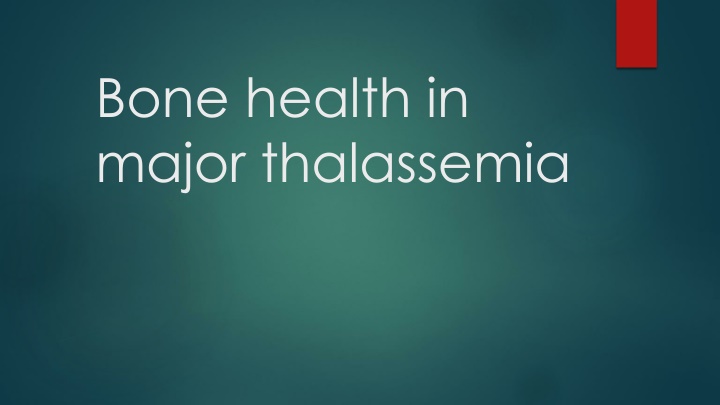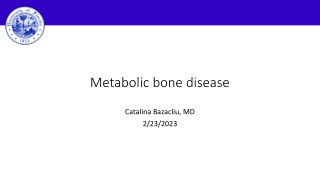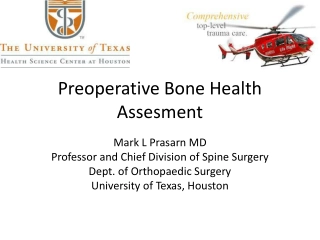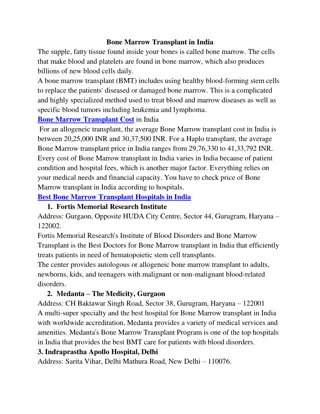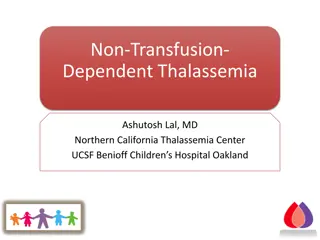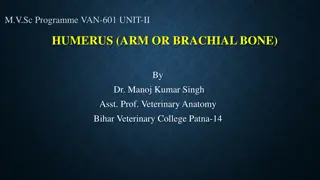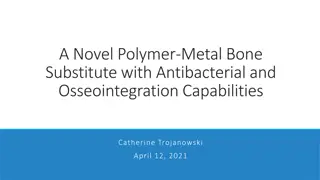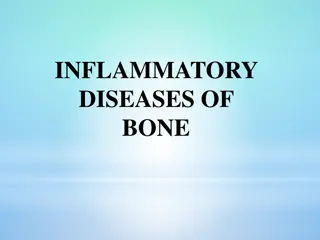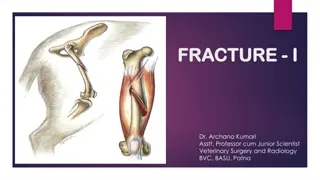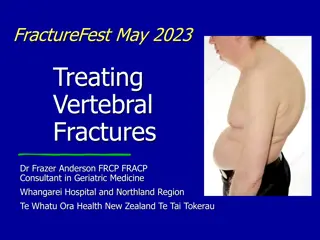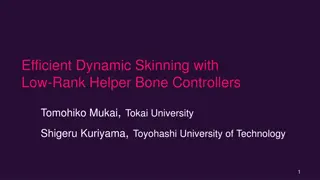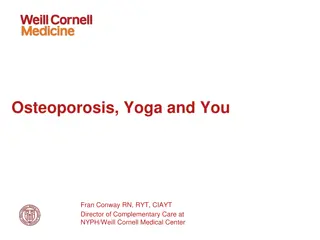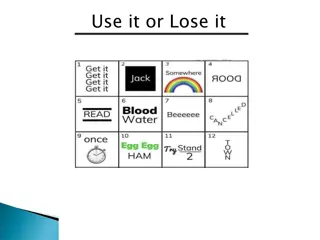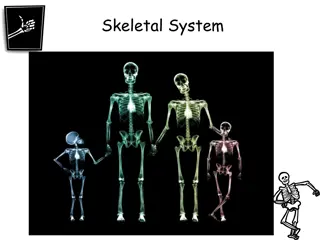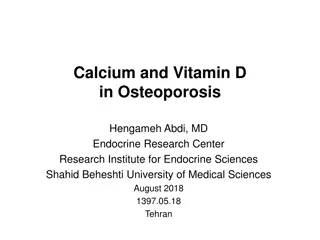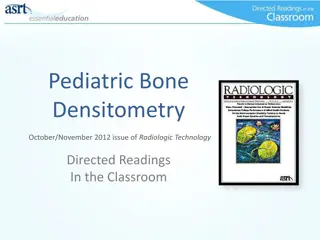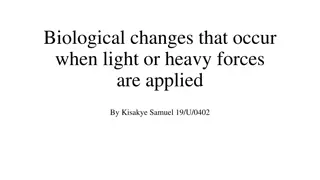Bone health in major thalassemia
The major bone complications in thalassemia intermedia and major include osteopenia/osteoporosis, limb shortening, delayed skeletal maturation, and cosmetic abnormalities. Despite improved treatments, osteoporosis remains a serious concern in thalassemia patients.
Download Presentation

Please find below an Image/Link to download the presentation.
The content on the website is provided AS IS for your information and personal use only. It may not be sold, licensed, or shared on other websites without obtaining consent from the author.If you encounter any issues during the download, it is possible that the publisher has removed the file from their server.
You are allowed to download the files provided on this website for personal or commercial use, subject to the condition that they are used lawfully. All files are the property of their respective owners.
The content on the website is provided AS IS for your information and personal use only. It may not be sold, licensed, or shared on other websites without obtaining consent from the author.
E N D
Presentation Transcript
Bone health in major thalassemia
Overview The major bone complications of thalassemia intermedia and thalassemia major are related to extramedullary hematopoiesis and expansion of the erythroid bone marrow which can lead to osteopenia/osteoporosis, premature limb shortening, delayed skeletal maturation, and changes in the structure of facial and other bones, leading to cosmetic and dental abnormalities and pathologic fractures. The severity of these complications tends to correlate with overall disease severity; it has been suggested that individuals with thalassemia major have a much higher rate of bone turnover than those with thalassemia intermedia. Although optimised blood transfusions and iron chelation programs have greatly increased the life expectancy of TM patients and prevented severe bone alterations, osteoporosis and osteopenia remain serious complications, even in well-transfused and well-iron chelated patients.
Osteoporosis definition Osteoporosis is a skeletal disorder characterized by compromised bone strength, predisposing to an increased risk of fracture. According to the World Health Organization, diagnosis of osteoporosis is based on: Fragility fractures (fall from a fall from standing height or less ,without major trauma ), particularly at the spine,hip ,wrist,humerus Bone mineral density (BMD) : T score assessed at the lumbar spine or the femoral neck: Osteoporosis is defined by a BMD that is 2.5 standard deviations (SD) or more below the mean value for a young adult (T-score less than or equal to -2.5 SD).
Osteoporosis definition in children and adolescents Diagnosis is not based upon densitometric criteria alone in children and adolescents and requires a clinically significant fracture history including: A nontraumatic vertebral compression fx presence of both a clinically significant fracture history (2 or more bone fxs by age 10 or, 3 or more bone fxs by age 19) and BMD Z- score less than or equal to -2.0 SD.
Prevalence In TM patients, it is very common to find low BMD values (osteopenia or osteoporosis) and in some studies up to 90%, even in optimally transfused and chelated patients. Prevalence of fractures in TM patients ranges from 16% to 49%, depending on study population and method of data collection Extremity fractures are the most common , in particular at the upper extremity. Vertebral fractures are usually underestimated, and their prevalence varies from 2.6% to 13%.
Pathogenesis TM patients, despite following a regular transfusional regimen, and receiving adequate sex hormone replacement and chelating therapy, show imbalanced bone turnover with an increased resorptive phase that is not followed by an appropriate neoformation rate, resulting in a decreased BMD ( an increase in resorption is generally followed by a corresponding increase in bone formation) , particularly at the vertebral level, where trabecular bone is mostly represented . Numerous acquired factors could lead to the inhibition of osteoblastic activity, such as a defective GH-IGF-1 axis, iron deposits in bone, or deferoxamine toxicity. Many studies have shown increased osteoclast activation in these patients, measuring markers of bone resorption. The mechanism responsible for this osteoclast activation in well-treated thalassemic patients could be related to the altered cytokines network, which is often observed in these patients.
Cytokines Network The receptor activator of nuclear factor kappa- (RANK)/ RANK ligand (RANKL)/osteoprotegerin (OPG) system regulates the activation and proliferation of osteoclast precursors. Studies, suggest that the ratio of RANKL/OPG is increased in patients with TM and osteoporosis. Other cytokines, such as interleukin (IL)-1 , IL-6 and tumor necrosis factor- , In particular IL-1 and IL-6 in TM patients , are recognised as important effectors in the pathogenesis of osteoporosis.
Bone marrow expansion Bone marrow expansion is considered as a major determinant of bone destruction in TM patients, and despite of regular blood transfusions, the ineffective erythropoiesis in TM is not fully suppressed, and expansion of the bone marrow may contribute to the decreased BMD. Bone loss in TM largely involves trabecular bone. In fact, the lumbar spine, which consists mostly of trabecular bone and with wide bone marrow spaces, is the most affected site in these patients. It has been speculated that the increased generation of cells of the erythropoietic lineage may adversely affect the proliferation and maturation of cells of the osteogenic lineage. Osteoclasts originate from a hemopoietic granulocyte-macrophage lineage. The cytokines that are involved in haematopoiesis are also involved in the development of osteoclasts ,therefore, it is possible that the mechanism that stimulates haematopoiesis in TM may also stimulate osteoclastic formation and/or activity.
Iron overload in Endocrine Glands A regular transfusional regimen is a cornerstone of TM treatment, but results in significant iron overload. Excessive iron is deposited in almost all tissues but primarily in the liver, heart and the endocrine glands. TM patients often present with multiple endocrine dysfunctions including growth failure, hypogonadism, diabetes, hypothyroidism, hypoparathyroidism and, less frequently, hypoadrenalism. Impaired puberty was the most common endocrine abnormality (over 70% of the participants). The prevalence of other endocrinopathies was much lower with 17.5% hypogonadism, 8.7% diabetes mellitus, 7.7% primary hypothyroidism and 7.6% hypoparathyroidism.
Hypogonadism Haemosiderosis of the pituitary gonadotrophic cells and iron deposition in the testes and ovaries are involved in the pathogenesis of hypogonadism . Hypogonadism is a well-recognised cause of osteoporosis and osteopenia, and studies showed that hypogonadism produces more severe bone loss in TM . In TM patients without evidence of hypogonadism because of hormone replacement therapy, bone status was less compromised and osteoporosis was observed only at the lumbar site, where the influence of bone marrow expansion is prominent. In hypogonadic patients, osteoporosis may be more severe and may also affect the femoral site.
GH-IGF-1 Axis Several studies showed that the GH-IGF-1 axis is altered in TM patients and they have significantly lower circulating levels of IGF-1 and the corresponding binding protein (IGFBP-3) than normal individuals. IGF-1 plays an important role in bone remodelling and low serum IGF levels decrease osteoblast proliferation and bone matrix formation. Also a positive correlation between BMD at the lumbar spine and IGF-1 concentration has been reported. The mechanisms responsible for the reduced action of the IGF-1/IGFBP- 3 axis in TM are still being debated. There is an impairment of GH secretion in a considerable proportion of TM patients, compatible with hypothalamic and/or pituitary damage,but It is unclear whether the IGF-1 level decreases before or after GH secretion dysfunction
Iron deposition in Bone Iron deposition in bone damages osteoid maturation and inhibits mineralization, resulting in focal osteomalacia. This is due to the incorporation of iron into crystals of calcium hydroxyapatite, which consequently affects the growth of hydroxyapatite crystals. There is increased mineralization lag time in TM patients.
Deferoxamine Subcutaneously administered deferoxamine was for a long time the treatment of choice for iron overload in TM. Deferoxamine also inhibits DNA synthesis, collagen formation and osteoblast differentiation and enhances osteoblast apoptosis. Data on bone safety of new oral chelating agents are still limited
Vitamine D Vitamin D deficiency is involved in the pathogenesis of osteoporosis in TM patients due to its regulatory effects on bone cells and calcium homeostasis. Lower 25-hydroxyvitamin D levels, in comparison to healthy controls, are a common finding and are inversely correlated with ferritin levels and age. Lower sun exposure due to reduced physical activity and defective skin synthesis associated with jaundice are probably responsible for this deficiency .
Genetic factors Genetic factors also have an important role in determining BMD in TM patients, although the genes responsible are poorly defined in this population. Some studies provide partially support for an association between BMD and specific COL1A1 and TGF- 1 gene polymorphism in TM. Vitamin D receptor (VDR) polymorphisms could also represent a risk factor for low BMD in adult TM patients.
According to the 2021 guidelines for the management of transfusion-dependent thalassemia, Bone health assessed if there is any evidence of growth retardation or bony abnormalities (eg, facial deformities). Bone density testing is done annually starting at the age of two years, with bone age films until age 10 assessment of BMD by dual-energy X-ray absorptiometry (DXA) should be performed every 24 months after the age of 10 years, accompanied by vertebral fracture assessment. In addition, annual assessment of bone health should include measurement of serum calcium, phosphate, alkaline phosphatase, 25 (OH) vitamin D, PTH (parathyroid hormone), and, ideally, one marker of bone formation, and one marker of bone resorption. Endocrine status Thyroid function annually (more frequently if there are signs consistent with thyroid dysfunction). Additional testing may be appropriate for children and adolescents with delayed puberty.
Preventive measures are of paramount importance: Encouragement of moderate to high-impact physical activity Avoidance of smoking Intake of adequate calcium, zinc, and vitamin D (may include measurement of serum levels) Early diagnosis and treatment of diabetes mellitus Prevention and/or correction of hypogonadism Adequate iron chelation when appropriate Blood transfusions to inhibit excessive bone marrow expansion In addition, specific anti-osteoporotic treatment should be initiated in patients with very low BMD values, progressive significant BMD loss and/ or fragility fractures . None of the currently available anti-osteoporotic agents has proven efficacy and safety beyond 10 years of treatment, whereas the osteoanabolic agent teriparatide is administered for only 2 years. Additionally, all these agents are contraindicated or should be administered with great caution in women who are pregnant or even of childbearing potential.
The up-to-date experience with pharmacological agents in the management of - TM-associated osteoporosis includes almost all commercially available anti osteoporotic agents, except for selective estrogenreceptor modulators (SERMS) and the novel osteoanabolic agents, abaloparatide and romosozumab. Since most of the osteoporotic -TM patients are premenopausal women or men, SERMs are not indicated. Currently there are no data available for the efficacy and safety of romosozumab and abaloparatide, in -TM associated osteoporosis. Indications for specific anti-osteoporotic treatment should be carefully balanced against the need for lifelong treatment, and the possible adverse effects of long-term BPs or the rebound phenomenon seen after denosumab discontinuation .
Efficacy and safety of anti- osteoporotic drugs in -TM associated osteoporosis
Bisphosphonates (BPs) are the most widely used drugs for the prevention and treatment of bone loss and this is also the case for -TM. Efficacy: Oral alendronate ,IV neridronate ,clodronate , pamidronate and zoledronate, and IM clodronate, have been tested against placebo or no therapy in randomized clinical trials (RCTs) and prospective observational studies . In general, BPs use in this setting resulted in a significant reduction in bone turnover markers (BTM), accompanied by improved BMD at all skeletal sites compared to baseline and placebo, with the exception perhaps of clodronate, which reduced BTM but did not improve BMD . Interestingly, BMD gains were comparable or even greater than those reported with the same agents in postmenopausal osteoporosis. Reduction of back pain has also been reported with neridronate and zoledronate.
Positive effect on bone quality has been reported in a small, non- randomized histomorphometry study, in which IV pamidronate was given in a dose of 1mg/kg monthly for 3 years . Alendronate is the only oral BP tested in -TM patients with osteoporosis. In an RCT directly comparing alendronate 10mg daily with IM clodronate 100mg every 10 days, alendronate performed better in terms of BMD increases. In contrast, in another RCT, IV monthly administration of pamidronate 90mg resulted in higher BMD increases at both the LS and femoral neck (FN) compared to oral alendronate 70 mg weekly .
Zoledronate seems to be the most efficacious BP in terms of BMD increases in -TM associated osteoporosis . The regimens that were used were 4mg every 3 or 6 months, which is much higher than the dose administered for postmenopausal osteoporosis (5mg yearly). The 3-monthy regimen resulted in higher reductions in BTM and significantly higher increases at the LS BMD with borderline higher increases at the FN BMD compared to the 6-monthly regimen. Importantly, BMD at the LS, the FN and the radius continued to increase up to 24 months after discontinuation of 1-year zoledronate treatment in both the 3-monthly and the 6-monthly regimen.
Safety The duration of BP treatment in -TM associated osteoporosis in studies does not exceed 3 years, thus the safety of their administration for longer periods in such patients remains unknown. For the given treatment periods BPs were generally well-tolerated, and the type as well as the frequency of reported adverse events where as expected, consisting of mild upper gastrointestinal toxicity (alendronate) , acute phase reaction (IV BPs), and local pain at the site of injection (IM BPs). However, given the young age of -TM patients and the necessity for longer-term BP administration, there are concerns regarding their longterm and reproductive safety , while their anti-fracture efficacy and their effects on morbidity and mortality remain currently unknown. It has been proposed that BPs should be discontinued in women who intend to conceive and be reinstituted after delivery, if indicated .
Three cases (2 females, 1 male) of osteonecrosis of the jaw have been reported with alendronate 70 mg weekly administered for 3.5-4 years. One patient had received pamidronate 60 mg/month for 2 years prior to alendronate. All 3 patients had been subjected to tooth extraction, a well-known predisposing factor for osteonecrosis of the jaw development . There is only one published case of atypical femoral fracture, in a 36- old male with -TM treated with zoledronate for 3 years but being off- treatment for 1 year before the event . BPs did not influence iron status or hemoglobin levels, supporting their safety from a hematological point of view .
Denosumab Increased RANKL/ OPG ratio is one of the key mechanisms of bone loss in -TM. In specific, the RANKL/OPG ratio remains at high levels despite the effective management of low hemoglobin levels and hormonal disorders, thereby enhancing the activity of osteoclasts and consequently favoring bone loss. Along these lines, denosumab (Dmab), a human monoclonal antibody binding RANKL, appears to be a rational treatment approach.
Efficacy In a study evaluating Dmab in -TM associated osteoporosis, 30 relatively young patients (age range: 17-32 years) received the usual 60mg SC 6-monthly dose over a period of 1 year. Along with a considerable reduction in bone resorption markers, noticeable increases at the LS and FN BMD (9% and 6%, respectively) were observed. In addition, a randomized placebo-controlled phase 2b study evaluated 63 patients (age range: 34 78 years; 32 received Dmab and 31 placebo) over a period of one year. BMD increased more at the LS and radius, but not at the FN, in the Dmab treated patients. Additionally, in contrast with placebo, Dmab reduced both formation and resorption BTM along with sRANKL and sRANKL/OPG ratio . In the placebo-controlled trial a significant reduction of bone pain was observed in the Dmab group.
Safety Available data regarding the safety profile of Dmab in patients with - TM associated osteoporosis is reassuring ,and most of the adverse events were mild and concerned gastrointestinal problems (nausea, abdominal pain, diarrhea),headache and fever, while hypocalcemia was observed in less than 10%. Special attention should be given to the susceptibility to upper respiratory system and gastrointestinal infections; increased incidence of these infections has been reported in patients treated with Dmab for postmenopausal and male osteoporosis , and -TM patients are already more prone to these events due to disease-dependent factors such as splenectomy, heart disease, and other comorbidities.
Finally, Dmab discontinuation is an issue of concern, as a rebound phenomenon in bone remodeling resulting in substantial BMD loss is expected, especially in those who have been treated for long periods, and a subsequent anti-resorptive treatment is not given . Considering the results from studies in postmenopausal osteoporosis and the data from BPs studies among -TM patients, sequential administration of zoledronate, and possibly alendronate, is expected to mitigate BMD losses following Dmab discontinuation, especially among -TM patients treated for up to 2.5 - 3 years with Dmab.
Osteoanabolic Treatment Teriparatide (TPTD) is the most widely used osteoanabolic agent, approved worldwide for the management of postmenopausal, male, and glucocorticoid-induced osteoporosis in adults. Osteoanabolic agents have superior antifracture efficacy compared with BPs, especially in patients at high fracture risk. Recent evidence suggest that osteoanabolic treatment preceding antiresorptive agents results in higher BMD gains. TPTD, increases bone formation by direct actions on osteoblast precursors and mature osteoblasts.
Information regarding the use of TPTD in patients with -TM associated osteoporosis is limited. Recently published the case series of 11 patients with -TM and established osteoporosis (6 males and 5 females, mean age 45 4.38 years) treated with TPTD for a mean duration of 18.7 7.0 months. The authors reported substantial improvements in BMD at the LS (19% and 22%) and at the TH (13% and 14.2%), at 12 and 24 months, respectively. Serum osteocalcin levels and bone formation marker procollagen type I N-terminal propeptide (P1NP) increased at the first year of treatment and remained above baseline by the end of the second year. No fractures occurred during treatment, while the pain visual analogue scale did not change.
Discontinuation of TPTD is followed by progressive loss of BMD , while subsequent treatment with BPs or Dmab results in further BMD gains. The FDA recently removed the 2-year in lifetime treatment limitation for TPTD in patients who remain at high risk for fracture. Thus, some -TM patients may benefit from a longer duration or a second course TPTD treatment. There are no data concerning combination therapy of TPTD with antiresorptive agents (i.e., zoledronate and Dmab) in patients with -TM, although favorable results have been reported in postmenopausal osteoporosis.
Safety In a study, 45% of the patient s cohort reported side effects, including bone pain (5/11), muscle pain (4/11) and fever (1/10), while 3 patients discontinued therapy. These symptoms are commonly encountered in patients with -TM, especially bone pain and chills. There was no association between Hb levels, chelation regimen or iron status and bone pain . Concerning calcium homeostasis, TPTD treatment may worsen hypercalciuria, that is already observed in up to one-third of patients with -TM. In a study, 24h urinary calcium levels increased by 30 mg, although the incidence of hypercalciuria (> 300 mg/24h) per se, did not change. However, in cases with concomitant hypoparathyroidism, TPTD may have a neutral effect on renal calcium excretion. Close monitoring and proper treatment adjustment is required, especially in patients with kidney stones (up to 18.1%) and/or under deferasirox therapy, that is known to increase urinary calcium excretion
Based on data from postmenopausal women and men with osteoporosis, an initial 1 to 3-year course of zoledronate or up to 5 years oral BPs would be a relatively safe approach for osteoporotic patients with -TM. Alternatively, a 3 to 5 years course of Dmab is also an option. Two years treatment with TPTD could be considered in cases of severe osteoporosis with fractures and should always be followed by a course of oral BPs of 1-2 years or one course of iv. administered zoledronate . Similarly, Dmab should be followed by treatment with BPs in order to prevent rapid BMD loss and the rebound in vertebral fracture risk. In this case, patients treated with Dmab for less than 2.5 years should be sequentially treated with 1-2 years of oral BPs or 1-2 years of zoledronate 5mg given annually. Patients with longer duration of Dmab treatment (>2.5 years) may require zoledronate infusion at 6 months intervals depending on BTM values or BMD changes.
After the initial treatment, absence of new or worsening osteoporotic fractures and stability of BMD values, even in the osteoporotic/ osteopenic range, should be reassuring for premenopausal women and younger men with -TM associated osteoporosis. On the contrary, progressive BMD decrease and/or new fragility fractures is an indication for re-initiating treatment . Transitioning from an antiresorptive to an osteoanabolic agent is considered less effective than the opposite , but should be considered in cases of treatment failure . Transitioning from one antiresorptive agent to another given at larger intervals (e.g., from oral BPs to IV zoledronate) or more potent (e.g., from oral BPs to Dmab) could also be considered. Combined administration of anti-osteoporotic agents, mainly TPTD with Dmab or zoledronate have shown a clear advantage over TPTD monotherapy in patients with severe postmenopausal osteoporosis, but such combinations have not been tested in -TM osteoporotic patients
Nevertheless, the treat to target concept applied to date for postmenopausal osteoporosis is probably also valid for -TM osteoporotic patients, suggesting that treatment decisions should be made targeting either stability in BMD or maintenance of low fracture risk . Concepts such as long-term treatment and drug-holiday, however, should be evaluated from a different point of view in these patients who have unique demographic (younger age) and pathophysiological (iron toxicity and anemia) characteristics of bone loss. A tailored treatment plan based on the patient s disease profile, needs, and preferences is what should be currently recommended among patients with -TM associated osteoporosis.
